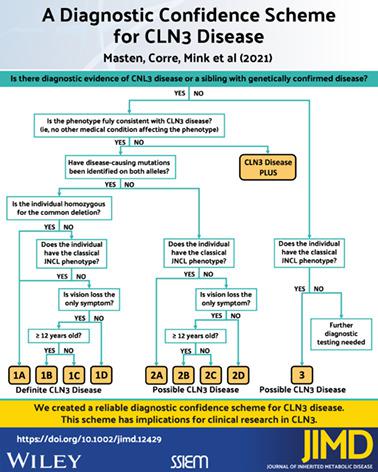当前位置:
X-MOL 学术
›
J. Inherit. Metab. Dis.
›
论文详情
Our official English website, www.x-mol.net, welcomes your feedback! (Note: you will need to create a separate account there.)
A diagnostic confidence scheme for CLN3 disease
Journal of Inherited Metabolic Disease ( IF 4.2 ) Pub Date : 2021-08-28 , DOI: 10.1002/jimd.12429 Margaux C Masten 1 , Camille Corre 1 , Alex R Paciorkowski 1 , Amy Vierhile 1 , Heather R Adams 1 , Jennifer Vermilion 1 , Grace A Zimmerman 1 , Erika F Augustine 1, 2 , Jonathan W Mink 1
Journal of Inherited Metabolic Disease ( IF 4.2 ) Pub Date : 2021-08-28 , DOI: 10.1002/jimd.12429 Margaux C Masten 1 , Camille Corre 1 , Alex R Paciorkowski 1 , Amy Vierhile 1 , Heather R Adams 1 , Jennifer Vermilion 1 , Grace A Zimmerman 1 , Erika F Augustine 1, 2 , Jonathan W Mink 1
Affiliation

|
Over the past 20 years, diagnostic testing for genetic diseases has evolved, leading to variable diagnostic certainty for individuals included in long-term natural history studies. Using genotype and phenotype data from an ongoing natural history study of CLN3 disease, we developed a hierarchical diagnostic confidence scheme with three major classes: Definite, Probable, or Possible CLN3 disease. An additional level, CLN3 Disease PLUS, includes individuals with CLN3 disease plus an additional disorder with a separate etiology that substantially affects the phenotype. Within the Definite and Probable CLN3 disease classes, we further divided individuals into subclasses based on phenotype. After assigning participants to classes, we performed a blinded reclassification to assess the reliability of this scheme. A total of 134 individuals with suspected CLN3 disease were classified: 100 as Definite, 21 as Probable, and 7 as Possible. Six individuals were classified as CLN3-PLUS. Phenotypes included the classical juvenile-onset syndromic phenotype, a “vision loss only” phenotype, and an atypical syndromic phenotype. Some individuals were too young to fully classify phenotype. Test-retest reliability showed 96% agreement. We created a reliable diagnostic confidence scheme for CLN3 disease that has excellent face validity. This scheme has implications for clinical research in CLN3 and other rare genetic neurodegenerative disorders.
中文翻译:

A diagnostic confidence scheme for CLN3 disease,CLN3 疾病的诊断置信度方案
Over the past 20 years, diagnostic testing for genetic diseases has evolved, leading to variable diagnostic certainty for individuals included in long-term natural history studies. Using genotype and phenotype data from an ongoing natural history study of CLN3 disease, we developed a hierarchical diagnostic confidence scheme with three major classes: Definite, Probable, or Possible CLN3 disease. An additional level, CLN3 Disease PLUS, includes individuals with CLN3 disease plus an additional disorder with a separate etiology that substantially affects the phenotype. Within the Definite and Probable CLN3 disease classes, we further divided individuals into subclasses based on phenotype. After assigning participants to classes, we performed a blinded reclassification to assess the reliability of this scheme. A total of 134 individuals with suspected CLN3 disease were classified: 100 as Definite, 21 as Probable, and 7 as Possible. Six individuals were classified as CLN3-PLUS. Phenotypes included the classical juvenile-onset syndromic phenotype, a “vision loss only” phenotype, and an atypical syndromic phenotype. Some individuals were too young to fully classify phenotype. Test-retest reliability showed 96% agreement. We created a reliable diagnostic confidence scheme for CLN3 disease that has excellent face validity. This scheme has implications for clinical research in CLN3 and other rare genetic neurodegenerative disorders.,在过去的 20 年中,遗传疾病的诊断测试不断发展,导致长期自然史研究中个体的诊断确定性不同。使用来自正在进行的 CLN3 疾病自然史研究的基因型和表型数据,我们开发了一个具有三个主要类别的分层诊断置信度方案:确定的、可能的或可能的 CLN3 疾病。一个额外的级别,CLN3 疾病 PLUS,包括患有 CLN3 疾病的个体以及具有显着影响表型的单独病因的额外疾病。在确定和可能的 CLN3 疾病类别中,我们根据表型进一步将个体分为亚类。在将参与者分配到班级后,我们进行了盲法重新分类以评估该方案的可靠性。共有 134 名疑似 CLN3 疾病的个体被分类:100 人为确定,21 人为可能,7 人为可能。六个人被归类为 CLN3-PLUS。表型包括经典的青少年发病综合征表型、“仅视力丧失”表型和非典型综合征表型。有些人太年轻,无法完全分类表型。重测信度显示 96% 的一致性。我们为 CLN3 疾病创建了一个可靠的诊断置信度方案,该方案具有出色的面部效度。该方案对 CLN3 和其他罕见遗传性神经退行性疾病的临床研究具有重要意义。和非典型综合征表型。有些人太年轻,无法完全分类表型。重测信度显示 96% 的一致性。我们为 CLN3 疾病创建了一个可靠的诊断置信度方案,该方案具有出色的面部效度。该方案对 CLN3 和其他罕见遗传性神经退行性疾病的临床研究具有重要意义。和非典型综合征表型。有些人太年轻,无法完全分类表型。重测信度显示 96% 的一致性。我们为 CLN3 疾病创建了一个可靠的诊断置信度方案,该方案具有出色的面部效度。该方案对 CLN3 和其他罕见遗传性神经退行性疾病的临床研究具有重要意义。
更新日期:2021-08-28
中文翻译:

A diagnostic confidence scheme for CLN3 disease,CLN3 疾病的诊断置信度方案
Over the past 20 years, diagnostic testing for genetic diseases has evolved, leading to variable diagnostic certainty for individuals included in long-term natural history studies. Using genotype and phenotype data from an ongoing natural history study of CLN3 disease, we developed a hierarchical diagnostic confidence scheme with three major classes: Definite, Probable, or Possible CLN3 disease. An additional level, CLN3 Disease PLUS, includes individuals with CLN3 disease plus an additional disorder with a separate etiology that substantially affects the phenotype. Within the Definite and Probable CLN3 disease classes, we further divided individuals into subclasses based on phenotype. After assigning participants to classes, we performed a blinded reclassification to assess the reliability of this scheme. A total of 134 individuals with suspected CLN3 disease were classified: 100 as Definite, 21 as Probable, and 7 as Possible. Six individuals were classified as CLN3-PLUS. Phenotypes included the classical juvenile-onset syndromic phenotype, a “vision loss only” phenotype, and an atypical syndromic phenotype. Some individuals were too young to fully classify phenotype. Test-retest reliability showed 96% agreement. We created a reliable diagnostic confidence scheme for CLN3 disease that has excellent face validity. This scheme has implications for clinical research in CLN3 and other rare genetic neurodegenerative disorders.,在过去的 20 年中,遗传疾病的诊断测试不断发展,导致长期自然史研究中个体的诊断确定性不同。使用来自正在进行的 CLN3 疾病自然史研究的基因型和表型数据,我们开发了一个具有三个主要类别的分层诊断置信度方案:确定的、可能的或可能的 CLN3 疾病。一个额外的级别,CLN3 疾病 PLUS,包括患有 CLN3 疾病的个体以及具有显着影响表型的单独病因的额外疾病。在确定和可能的 CLN3 疾病类别中,我们根据表型进一步将个体分为亚类。在将参与者分配到班级后,我们进行了盲法重新分类以评估该方案的可靠性。共有 134 名疑似 CLN3 疾病的个体被分类:100 人为确定,21 人为可能,7 人为可能。六个人被归类为 CLN3-PLUS。表型包括经典的青少年发病综合征表型、“仅视力丧失”表型和非典型综合征表型。有些人太年轻,无法完全分类表型。重测信度显示 96% 的一致性。我们为 CLN3 疾病创建了一个可靠的诊断置信度方案,该方案具有出色的面部效度。该方案对 CLN3 和其他罕见遗传性神经退行性疾病的临床研究具有重要意义。和非典型综合征表型。有些人太年轻,无法完全分类表型。重测信度显示 96% 的一致性。我们为 CLN3 疾病创建了一个可靠的诊断置信度方案,该方案具有出色的面部效度。该方案对 CLN3 和其他罕见遗传性神经退行性疾病的临床研究具有重要意义。和非典型综合征表型。有些人太年轻,无法完全分类表型。重测信度显示 96% 的一致性。我们为 CLN3 疾病创建了一个可靠的诊断置信度方案,该方案具有出色的面部效度。该方案对 CLN3 和其他罕见遗传性神经退行性疾病的临床研究具有重要意义。



























 京公网安备 11010802027423号
京公网安备 11010802027423号